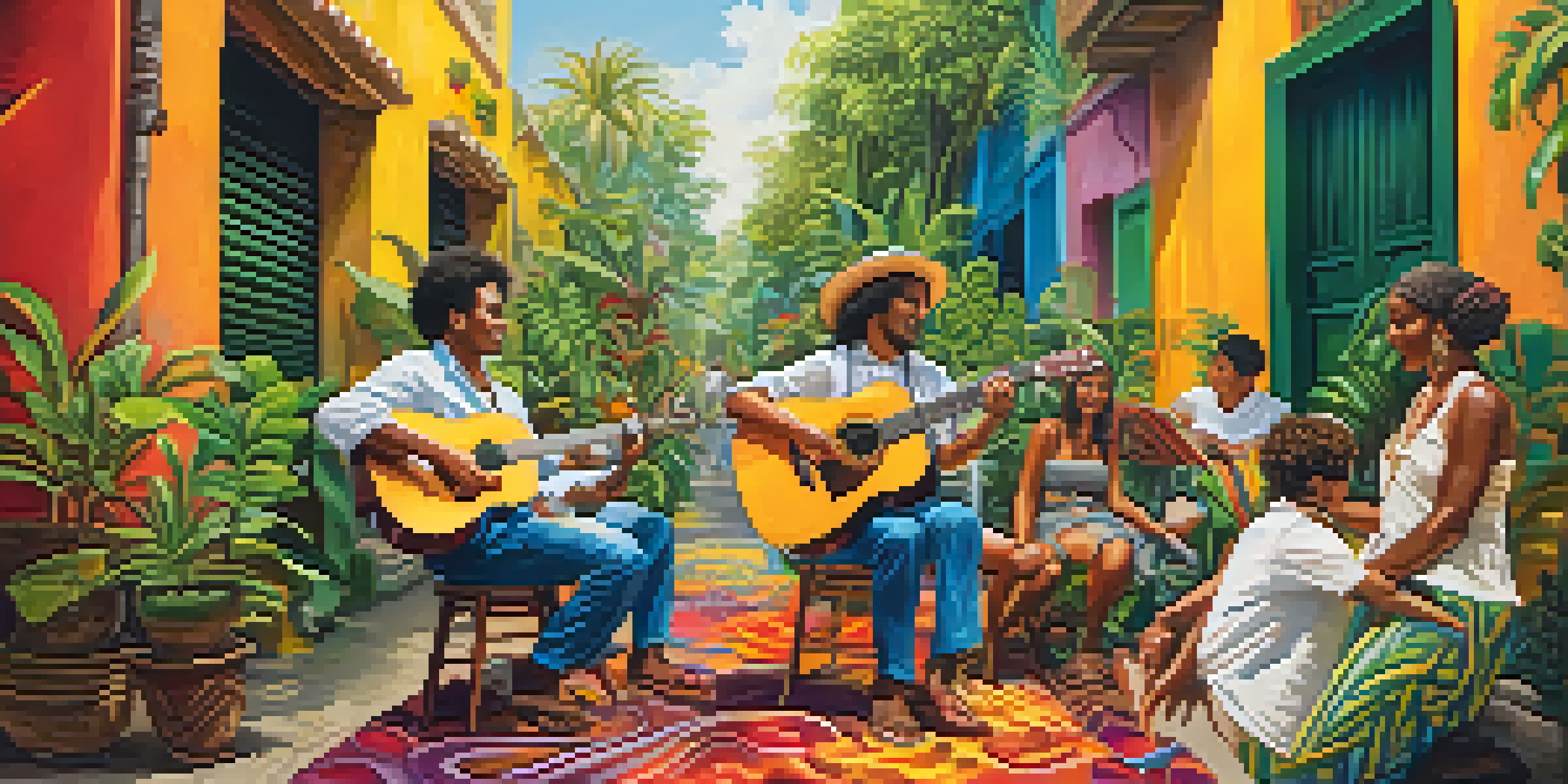Guitar in World Music: A Journey Through Global Sounds

The Guitar: A Universal Instrument Across Cultures
The guitar has traveled far beyond its Spanish origins, becoming a staple in musical traditions around the globe. Its versatility allows for a wide range of sounds, making it adaptable to various genres, from rock to flamenco. Whether it's a six-string acoustic or an electric model, the guitar speaks a universal language that resonates with people everywhere.
The guitar is a versatile instrument, capable of expressing a wide range of emotions and styles, connecting people across cultures.
In many cultures, the guitar is more than just an instrument; it's a symbol of identity and expression. For example, in Brazil, the guitar is central to samba music, providing the rhythm and melody that define the genre. Similarly, in African music, different types of guitars like the kora and ngoni contribute to rich storytelling traditions, showcasing the guitar's ability to weave cultural narratives.
As it integrates into local music scenes, the guitar evolves, taking on new forms and techniques. This adaptability not only enriches the music but also fosters cultural exchange, allowing musicians from different backgrounds to collaborate and create fusion genres. The guitar, thus, serves as a bridge that connects diverse musical heritages.
The Acoustic Guitar's Role in Folk Traditions
Acoustic guitars have long been the backbone of folk music around the world, from American bluegrass to Irish ballads. The warm, resonant sound of the acoustic guitar creates an intimate atmosphere, perfect for storytelling through song. In folk traditions, the guitar often accompanies a singer, providing a melodic foundation that enhances lyrical themes of love, loss, and social commentary.

For instance, in the Appalachian region of the United States, the acoustic guitar plays a key role in the bluegrass genre, blending with banjos and fiddles to create a distinct sound. Similarly, in the Andes, the charango, a small stringed instrument related to the guitar, enriches traditional folk music with its high-pitched tone. These instruments not only signify regional identity but also connect generations through shared musical experiences.
Guitar's Global Cultural Impact
The guitar transcends its origins, adapting to and enriching various musical traditions worldwide.
As folk music continues to evolve, the acoustic guitar remains a beloved instrument for both traditional and contemporary artists. Musicians use it to keep age-old stories alive while also experimenting with new sounds and styles. The acoustic guitar, therefore, stands as a testament to the enduring power of folk music across cultures.
Electric Guitar: The Heart of Global Rock Music
The electric guitar revolutionized music in the 20th century, becoming an iconic symbol of rock and roll. With its powerful sound and ability to produce various effects, it has become a favorite among musicians worldwide. From the gritty riffs of blues to the explosive solos in heavy metal, the electric guitar shapes the soundscape of modern music.
Music is the universal language of mankind, and the guitar is one of its most eloquent speakers.
In countries like the UK and the US, the electric guitar has been instrumental in the birth of numerous sub-genres, influencing countless artists and bands. The British Invasion of the 1960s, led by bands like The Beatles and The Rolling Stones, showcased the electric guitar's versatility and appeal. This trend soon spread globally, inspiring musicians in Latin America, Asia, and Africa to incorporate electric guitars into their music.
As rock music continues to evolve, the electric guitar remains at its core, encouraging cross-cultural collaborations. Artists from different backgrounds blend rock with local styles, creating unique fusions that celebrate their heritage while embracing modern influences. The electric guitar, thus, serves as a powerful tool for innovation and cultural expression.
Traditional Guitars: A Glimpse into Cultural Heritage
Around the world, traditional guitars reflect the unique cultural heritage of their regions. Instruments like the oud in the Middle East and the guitárra in Spain showcase the diverse craftsmanship and musical styles tied to specific histories. Each traditional guitar carries the stories, techniques, and sounds of its culture, often passed down through generations.
In India, the sitar—though not a guitar in the traditional sense—shares similarities and has influenced guitarists worldwide. Its intricate melodies and rhythms have inspired fusion genres, blending eastern and western musical traditions. This cross-pollination emphasizes how traditional instruments can coexist and enhance each other, creating rich musical tapestries.
Acoustic Guitar in Folk Music
Acoustic guitars serve as the backbone of folk music, providing a melodic foundation for storytelling across cultures.
As globalization continues to influence music, traditional guitars play a crucial role in preserving cultural identities. Musicians often seek to honor their roots while adapting to contemporary styles, ensuring that the legacy of their traditional instruments remains alive. This dynamic interplay between tradition and innovation highlights the significance of traditional guitars in world music.
Guitar in Latin Music: From Flamenco to Salsa
Latin music is a vibrant tapestry woven with diverse rhythms and sounds, and the guitar plays a pivotal role in many of its genres. Flamenco, originating from Spain, is perhaps one of the most passionate expressions of guitar music, where intricate fingerpicking and percussive strumming create a captivating auditory experience. The guitar here not only serves as an instrument but as an essential storyteller of emotion and culture.
In Latin America, the guitar takes on various forms, from the acoustic guitar in bossa nova to the electric guitar in salsa and tango. Each genre showcases the guitar's adaptability and cultural significance, allowing musicians to express their identities while celebrating their heritage. The guitar's rhythmic patterns and melodic lines often drive the energy of these vibrant musical styles.
As Latin music continues to gain global popularity, the guitar remains central to its evolution. Cross-cultural collaborations have emerged, leading to innovative fusions that blend traditional Latin sounds with modern genres. The guitar, therefore, acts as a unifying force, bringing together diverse musical influences and creating new pathways for artistic expression.
The Guitar's Influence in African Music Styles
The guitar has a profound impact on African music, where it blends seamlessly with traditional rhythms and storytelling. Instruments like the ngoni and the thumb piano (kalimba) are often used alongside guitars, creating rich, layered sounds that resonate with cultural significance. The guitar's ability to adapt to various regional styles allows it to play a vital role in both traditional and contemporary African music.
In countries like Mali, the acoustic guitar is central to the music of the griots, who are traditional storytellers and musicians. They weave history and culture into their songs, using the guitar to accompany their narratives. This connection between the guitar and oral traditions highlights the instrument's importance in preserving and sharing cultural stories.
Electric Guitar in Modern Genres
The electric guitar is central to the evolution of rock music, fostering cross-cultural collaborations and innovation.
As African music has gained international recognition, the guitar has become a symbol of this rich heritage. Musicians are now incorporating modern styles, creating unique fusions that celebrate their roots while appealing to a global audience. The guitar, thus, stands as a testament to Africa's vibrant musical landscape and its lasting influence on world music.
Guitar in Asian Music: A Fusion of Tradition and Modernity
In Asia, the guitar has found its place amid a rich tapestry of traditional music. Instruments like the shamisen in Japan and the sitar in India showcase the continent's diverse musical heritage. However, the guitar has emerged as a versatile instrument, blending seamlessly with these traditional sounds while also standing alone in contemporary music scenes.
In recent years, Asian musicians have begun to infuse traditional music with guitar-driven styles, leading to innovative fusions that resonate with younger audiences. For example, in India, contemporary artists are experimenting with rock and pop influences, creating a unique sound that honors traditional melodies while embracing modernity. This blend not only attracts new listeners but also revitalizes interest in traditional forms.

As global music trends continue to evolve, the guitar remains an essential tool for artistic expression in Asia. Musicians are using it to explore their identities and connect with audiences worldwide. The guitar, therefore, serves as a bridge between the past and present, allowing for a dynamic exchange of musical ideas across cultures.